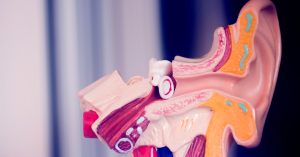Have you ever found yourself nodding along in a conversation at a busy restaurant, struggling to make out what your friend just said? Or maybe you can hear perfectly well in quiet settings but get completely lost in noisy environments like family gatherings or crowded events. If this sounds familiar, you’re not alone — and you’re not imagining things.
Difficulty hearing in noise is one of the most common complaints among people with hearing loss, especially those over 50. While many expect hearing loss to mean a general reduction in volume, it often presents more subtly: voices become harder to distinguish from background noise, speech sounds blurred, and following group conversations becomes exhausting. Even people with relatively mild hearing loss — or normal hearing on a test — can experience these challenges.
Understanding why this happens involves more than just looking at your ears. Your brain plays a huge role in processing and interpreting sound, especially when competing noise is involved. In this article, we’ll break down what’s really going on when you struggle to hear in noisy places and what you can do about it. From the science of how hearing works to real-life tips and when to seek help, we’ll guide you through everything you need to know.
How Hearing Works in Quiet vs. Noisy Settings
To understand why hearing in noise is so difficult, it helps to first look at how our auditory system works — and how it responds differently in quiet versus noisy environments. Hearing is not just about your ears; it’s a complex process that involves your brain interpreting sound signals from the environment. When everything is functioning smoothly, your brain can effortlessly focus on speech, filter out distractions, and make sense of conversations. But in noisy places, that system faces major challenges.
In a quiet setting, sounds like voices or music enter your ear canal, vibrate the eardrum, and are transmitted through tiny bones to the cochlea — a spiral-shaped organ in the inner ear. Inside the cochlea, thousands of tiny hair cells convert these vibrations into electrical signals. These signals travel up the auditory nerve to the brain, where they’re processed and understood as meaningful sounds like words or music. In silence, this process is relatively clean and efficient.
However, when background noise is introduced — such as clinking dishes, overlapping conversations, or traffic noise — the situation becomes much more complex. Your brain now has to separate the voice you want to hear from all the other sounds bombarding your ears. This ability is called speech-in-noise processing, and it relies on highly sophisticated auditory and cognitive functions, including memory, attention, and the brain’s capacity to predict what comes next in a sentence.
For people with normal hearing and strong cognitive processing, the brain usually does a good job of filtering out the noise. But for those with even mild hearing loss, aging-related changes, or auditory processing difficulties, the system gets overwhelmed. Background sounds can mask important speech cues, and consonants like “s,” “f,” or “t” — which are critical for speech clarity — may become indistinguishable from the noise. It’s not that the voice is too quiet; it’s that it’s no longer clear.
This is why many people report that they can “hear” but not “understand” in noisy places. Their ears are picking up the sound, but their brain is having trouble decoding it. The problem becomes even more noticeable in environments with a lot of overlapping voices, poor acoustics, or fast-paced conversations.
In short, hearing in noise is a balancing act between your ears and brain — and when that balance is disrupted, understanding speech becomes an uphill battle.
Common Causes of Difficulty Hearing in Noise
If you find it particularly hard to follow conversations in noisy places, you’re not alone — and there’s usually a clear reason why. The ability to hear speech in background noise relies on a finely tuned system involving your ears and your brain. When that system is disrupted by hearing loss or other issues, noisy environments become especially challenging. Let’s take a closer look at the most common causes behind this struggle.
Sensorineural Hearing Loss
By far the most frequent cause is sensorineural hearing loss, which results from damage to the tiny hair cells in the cochlea or the auditory nerve itself. These cells are responsible for detecting sound frequencies and sending that information to your brain. When they’re damaged — due to age, noise exposure, or illness — it becomes harder to distinguish speech sounds from noise. This type of hearing loss typically affects high-frequency sounds first, which are crucial for understanding consonants like “s,” “f,” and “th.”
Age-Related Hearing Changes
As we age, even without significant hearing loss on an audiogram, our auditory system can decline. This age-related decline, known as presbycusis, affects both the ear and the brain’s ability to process sound. Older adults often report difficulty understanding speech in noise, even if they “pass” a hearing test. That’s because the tests usually measure hearing in quiet, not in realistic, noisy environments where people spend much of their time.
Auditory Processing Disorder (APD)
Some individuals may have normal hearing thresholds but still struggle in noisy settings due to auditory processing disorder (APD). This condition affects the brain’s ability to interpret and organize sounds, making it difficult to focus on one voice in a crowd or follow rapid speech. APD can occur at any age but often becomes more apparent later in life as cognitive function naturally changes.
Cognitive Decline
Cognition plays a big role in how we understand speech. Attention, memory, and the brain’s ability to fill in missing pieces of conversation all contribute to communication in noise. When cognitive function declines — due to aging, dementia, or other conditions — the brain’s support system for hearing can falter, making background noise more disruptive.
Fatigue and Listening Effort
Constantly trying to make sense of garbled speech takes a toll. Many people with hearing difficulties report listening fatigue, especially after social events in noisy places. When your brain has to work overtime to fill in the gaps, it becomes mentally exhausting. Over time, this can lead to frustration, withdrawal from social situations, and reduced quality of life.
Understanding these underlying causes is a vital first step toward finding effective solutions. The good news? There are ways to manage and even improve hearing in noise — from technology to training, which we’ll explore next.
Why It’s Not Just About Hearing Aids
When people struggle to hear in noisy environments, the first solution that often comes to mind is hearing aids. And while hearing aids are incredibly helpful for many, they’re not a magic fix — especially when it comes to background noise. In fact, many users report that while hearing aids make sounds louder, they don’t always make them clearer in noisy situations. That’s because hearing in noise involves more than just amplification.
The Limits of Amplification
Traditional hearing aids are designed to amplify sounds based on your hearing profile. However, in a noisy restaurant or crowded family gathering, they amplify everything — including the background chatter, clinking dishes, and ambient music. This can make it harder to isolate the person you’re trying to hear, especially if your hearing loss includes damage to high-frequency processing or distortion of sound signals.
Speech Clarity vs. Loudness
One of the most common frustrations is that voices are louder with hearing aids, but still difficult to understand. That’s because speech clarity depends on more than volume. It relies on your brain’s ability to distinguish subtle differences in sound — something that can be impaired by hearing loss or aging. Hearing aids can’t fully restore damaged auditory processing or replace lost hair cells in the cochlea.
Advanced Hearing Aid Features
That said, modern hearing aids have come a long way, and many now include features specifically designed to help in noisy settings:
- Directional microphones help focus on sound coming from in front of you while minimizing noise from other directions.
- Digital noise reduction uses algorithms to reduce constant background noise, like air conditioning or traffic.
- Bluetooth connectivity allows direct streaming from smartphones or assistive microphones, improving signal-to-noise ratio.
While these technologies can make a significant difference, they still require adjustment, customization, and often some practice to use effectively in real-life situations.
Auditory Training and Brain Support
Another overlooked piece of the puzzle is auditory training — programs and exercises that help your brain adapt to hearing aids and improve sound processing in noise. These may include apps, group classes, or sessions with a hearing specialist. Over time, auditory training can improve your brain’s ability to focus on speech, ignore distractions, and rebuild confidence in social settings.
The key takeaway? Hearing aids are incredibly valuable tools, but they work best when combined with proper fitting, realistic expectations, and training. They’re one part of a larger solution that includes both technology and behavioral strategies.
Real-World Strategies for Hearing Better in Noise
Even with the best hearing aids, noisy environments can still be tough to navigate. But there’s good news — there are practical, real-world strategies that can make a big difference in how well you hear and communicate in challenging settings. By adjusting your environment, using smart tools, and changing how you interact, you can take back control and reduce the frustration that background noise often brings.
Choose Your Seat Wisely
Where you sit in a room can dramatically impact your ability to hear. In restaurants, try to:
- Sit with your back to a wall to reduce noise coming from behind.
- Choose corners or booths rather than open tables.
- Face the person you’re speaking to so you can use visual cues like lipreading and facial expressions.
Lighting also matters — good lighting helps you read lips and body language more easily, both of which support better understanding.
Reduce Background Noise
Whenever possible, take steps to reduce competing sounds:
- Turn off background music or lower the volume.
- Close windows to minimize street noise.
- Choose quieter times to dine out or schedule social events (like mid-afternoon).
If you’re at home, carpets, curtains, and soft furniture can absorb sound and make speech easier to hear.
Use Assistive Listening Devices
In addition to hearing aids, many people benefit from assistive listening devices (ALDs). These include:
- Personal amplifiers with microphones you can place near the speaker.
- FM systems or remote mics that transmit sound directly to your hearing aids.
- Loop systems commonly found in theaters or churches, which send sound wirelessly to hearing aids equipped with a telecoil.
Even smartphone apps can help by providing live captions or sound amplification in real time.
Communication Techniques
Adopting a few simple habits can improve understanding:
- Ask people to speak clearly, not louder.
- Request they face you while talking and avoid covering their mouths.
- Let them know when you’re having difficulty — most people are happy to help once they know.
You can also repeat back part of what you heard to confirm: “Did you say we’re meeting at 5 or 6?”
Take Listening Breaks
Straining to hear in noise is mentally tiring. Give yourself permission to take breaks:
- Step outside for a few minutes to reset.
- Pace your social time to avoid listening fatigue.
- Practice self-care — rest, hydration, and stress reduction all support better hearing performance.
Remember, hearing well in noise isn’t just about technology. It’s about being proactive, making adjustments, and using every tool available — both physical and behavioral — to set yourself up for success.
When to See a Specialist
Struggling to hear in noisy places isn’t just a normal part of aging — it can be a sign of an underlying hearing or auditory processing issue that deserves attention. The earlier you seek professional guidance, the more options you’ll have for improving your hearing and protecting your long-term quality of life. But when is it time to take that next step?
Signs You Shouldn’t Ignore
If you’re experiencing any of the following, it’s wise to consult a hearing specialist:
- You often ask people to repeat themselves, especially in groups or noisy places.
- Conversations in restaurants, meetings, or social events are exhausting or confusing.
- You feel embarrassed or frustrated because you can’t follow along.
- Family or friends are pointing out that you’re missing things in conversation.
- You’ve started avoiding noisy settings altogether.
Even if your hearing seems “fine” in quiet environments, these challenges may indicate subtle changes that a standard hearing test can detect.
What to Expect at an Evaluation
A visit to an audiologist or hearing specialist usually includes:
- A hearing test (audiogram) to assess your ability to hear different tones and speech.
- Speech-in-noise testing to measure how well you understand speech amid background noise.
- A review of your medical history and lifestyle to understand what might be contributing to your difficulties.
The results will help the specialist determine whether you have hearing loss, auditory processing issues, or other factors affecting your communication.
The Importance of Early Intervention
Hearing challenges, especially in noise, often develop gradually. Many people wait years before seeking help — by which time the brain may have already adapted to hearing less, making treatment more difficult. Early intervention not only improves communication but may also help preserve cognitive function. Research shows that untreated hearing loss is linked to a greater risk of social isolation, depression, and even dementia.
It’s Not Just About Hearing Aids
Seeing a specialist doesn’t automatically mean you’ll need hearing aids. You might benefit from:
- Counseling and education about your hearing health
- Custom communication strategies
- Recommendations for assistive devices or apps
- Auditory training programs to improve brain processing
Most importantly, a specialist can guide you through your options and help you build a hearing care plan that fits your needs and lifestyle.
Seeking help is a sign of strength — not weakness. With the right support, many people experience significant improvements in their ability to hear and connect, even in challenging listening environments.
Conclusion
If you’ve ever wondered, “Why can’t I hear in noise?” — now you know you’re far from alone. Difficulty understanding speech in noisy environments is a common and often frustrating experience, especially for older adults or those with hidden hearing challenges. But this struggle isn’t just about your ears; it’s also about how your brain processes sound, how background noise masks speech, and how even small changes in hearing can create big challenges in real-world settings.
Fortunately, understanding the reasons behind the problem is the first step toward finding relief. From exploring the mechanics of hearing to identifying common causes like sensorineural hearing loss, auditory processing issues, or aging-related decline, you now have the knowledge to recognize what’s happening. More importantly, you’ve learned that hearing aids — while valuable — are only part of the solution.
Real improvements come from a combination of smart hearing technology, personalized strategies, and proactive care. Whether it’s choosing better seating, using assistive devices, or simply knowing when to seek help, you have tools available to navigate noisy environments with more confidence and ease.
You don’t have to accept hearing difficulties as a fact of life. If noise is interfering with your ability to enjoy conversations, social gatherings, or daily routines, don’t wait. Reach out to a hearing specialist and take that important first step toward hearing more clearly — even in the noise.
FAQ
Why can I hear fine in quiet but not in noise?
This is a common issue caused by the brain’s difficulty separating speech from background noise, especially if there is hearing loss or aging-related changes. In quiet environments, there’s less competition for your attention, but noisy places make it harder for your brain to filter out distractions and focus on speech.
Are there hearing aids that work better in noisy environments?
Yes. Many modern hearing aids come with features like directional microphones, digital noise reduction, and connectivity to remote microphones or smartphones. These tools help reduce background noise and focus on the speaker’s voice, but results still depend on proper fitting and training.
Can I have normal hearing but still struggle in noisy places?
Absolutely. Some people have normal results on a standard hearing test but still have trouble in noisy settings due to auditory processing disorder (APD) or age-related brain changes. Specialized tests can assess these difficulties more accurately.
What’s the best way to improve my hearing in restaurants or crowds?
Start by choosing quieter seating, facing your conversation partner, and reducing surrounding noise when possible. Use assistive technology like personal microphones or speech-to-text apps. Let others know you’re having difficulty so they can speak more clearly and face you directly.
Should I see a doctor or audiologist about this?
Yes. If hearing in noise is becoming a problem, a hearing professional can perform a detailed evaluation and suggest appropriate treatments — from hearing aids to communication strategies or training programs. Early intervention leads to better outcomes.
This article is for informational purposes only and is not a substitute for professional medical advice, diagnosis, or treatment. If you are concerned about your hearing or ear health, please consult a qualified healthcare provider.






